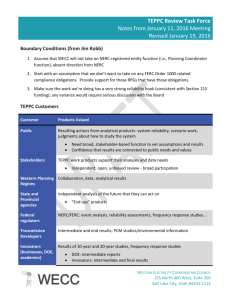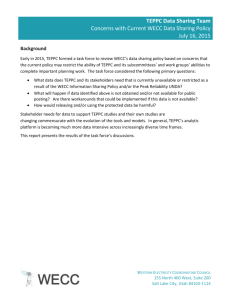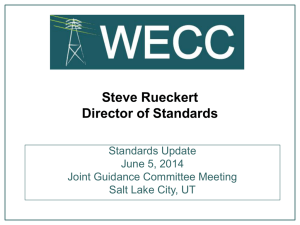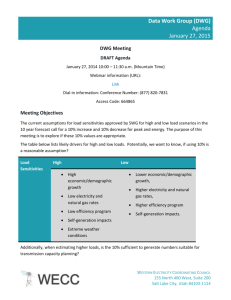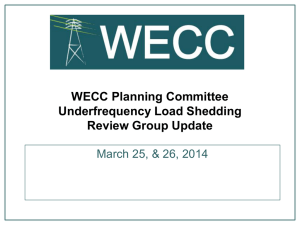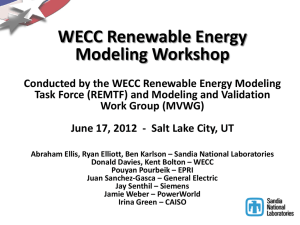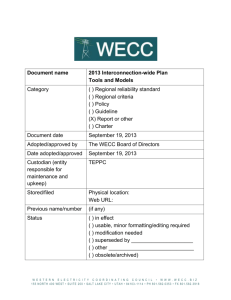TEPPC 2015 Work Plan - Western Electricity Coordinating Council
advertisement
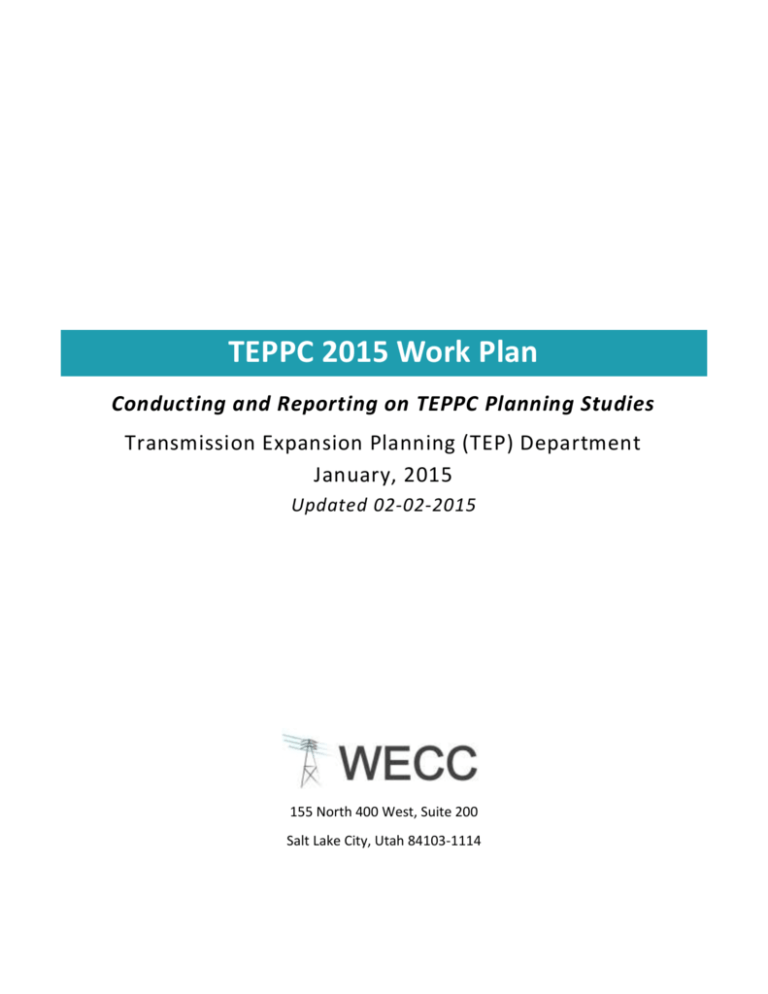
TEPPC 2015 Work Plan Conducting and Reporting on TEPPC Planning Studies Transmission Expansion Planning (TEP) Department January, 2015 Updated 02-02-2015 155 North 400 West, Suite 200 Salt Lake City, Utah 84103-1114 TEPPC 2015 Work Plan i Executive Summary In 2013, WECC published the 2013 WECC Interconnection-wide Transmission Plan. This collection of documents, totaling approximately 1,800 pages, as well as a large number of accompanying presentations, was a comprehensive report on transmission planning activities completed in the preceding two years. In 2014, WECC began a discussion with TEPPC and its stakeholders to explore the question, “how can Transmission Expansion Planning (TEP) staff and TEPPC report most effectively on their planning activities?” TEPPC and its stakeholders reviewed multiple whitepapers and presentations to consider alternate reporting approaches. In October, 2014, TEPPC and the SPSG unanimously approved a “hybrid” approach to reporting1 that would keep the most valuable existing products and adopt new reporting techniques and tools to provide greater efficiency in understanding the importance and impact of the results of planning studies. This report offers details on a possible implementation approach to the “hybrid” reporting system for consideration and review by TEPPC. 1 At its October 29-30, 2014 meeting, TEPPC unanimously approved a motion to implement the Hybrid reporting structure as outlined in the white paper on Adapting WECC’s Interconnection-wide Transmission Plan. W E S T E R N E L E C T R I C I T Y C O O R D I N A T I N G C O U N C I L TEPPC 2015 Work Plan ii Table of Contents Introduction...................................................................................................................................... 1 Hybrid Approach Overview ............................................................................................................... 1 1. Maintaining a Public Database of Planning Data and Models ......................................................... 3 2. Facilitating an Interconnection-Wide Transmission Expansion Planning Process .......................... 3 3. Performing Technical, Reliability and Economic Analysis of the Western Interconnection ........... 3 4. Preparing Interconnection-Wide Reliability Assessment Report .................................................... 4 TEPPC Work Products ........................................................................................................................ 4 Section 1: Public Database of Planning Data and Models ................................................................... 6 Section 2: Interconnection-Wide Transmission Expansion Reliability Assessment Process .................. 7 Section 3: Technical, Reliability and Economic Analyses of the Western Interconnection ................... 8 Section 4: Interconnection-Wide Reliability Assurance Report ........................................................... 9 Timeline.......................................................................................................................................... 12 W E S T E R N E L E C T R I C I T Y C O O R D I N A T I N G C O U N C I L TEPPC 2015 Work Plan 1 Introduction The expanding magnitude and scope of WECC’s transmission expansion planning activities have amplified the challenges in reporting study results. In recent years, the Interconnection-wide Transmission Plan has grown and evolved considerably as it has attempted to cover the “issue dejour:” summarize and evaluate each study evaluated in written form, and meet the information needs of a broad range of stakeholders. The 2013 WECC Interconnection-wide Transmission Plan totaled approximately 1,800 pages, including summaries, 10- and 20-year study reports, path reports and appendices. The presentation materials used to discuss the Plan with stakeholders added hundreds of additional pages. In view of the current issues, studies, reports and stakeholder information requests, it may no longer be feasible to continue the current process where all information is rolled into a single document. Stakeholders can have difficultly identifying the most critical nuggets of information in a document that spans 1,800 pages. In 2014, TEPPC reviewed several whitepapers and presentations that offered alternative methods for reporting on its transmission analysis activities. In October, 2014, both TEPPC and the Scenario Planning Steering Group (SPSG) unanimously approved a “hybrid” reporting approach that would synthesize the best elements of timely reporting, efficient report preparation and review and comprehensively and timely reviewing issues that significantly impact WECC’s ability to assure the reliability of the Bulk Electric System in the Western Interconnection. Additionally, in 2014, WECC CEO James Robb introduced the Integrated Reliability Assurance Model (IRAM) designed to identify, analyze and address the top reliability challenges facing the Western Interconnection. The IRAM applies WECC’s unique perspective as the reliability assurer for the Western Interconnection to integrate ongoing activities in Registered Entity oversight, reliability planning, performance analysis and stakeholder outreach. Its goal is to leverage WECC’s independence, expertise and analytical capabilities to provide value-added services to assure the reliability of the Western Interconnection. This paper attempts to develop in greater detail how WECC, through TEPPC, the TEP Department and stakeholders in the Western Interconnection, could complete its work that supports the goals of IRAM and report timely, efficiently and effectively on their activities through each planning cycle. Hybrid Approach Overview2 During review of reporting alternatives in July through September of 2014, TEPPC stakeholders expressed their general support for an issue-based reporting system that would facilitate timely reporting on significant planning issues. But, they also voiced concerns that eliminating a transmission 2 See “Adapting WECC’s Interconnection-wide Transmission Plan.” W E S T E R N E L E C T R I C I T Y C O O R D I N A T I N G C O U N C I L TEPPC 2015 Work Plan 2 plan such as the one created in 2013 could sacrifice the broad, regional perspective on transmission planning that WECC’s Interconnection-wide planning activities offer. Stakeholders wanted assurance that WECC would maintain its ability to connect various planning studies, review trends across the Western Interconnection, evaluate planning-related policies with analytical studies and maintain the option of preparing an Interconnection-wide reliability assessment and transmission plan. To address these concerns, the hybrid approach would preserve the flexibility and timeliness of the issue-based reporting system while including biennial Interconnection-wide reviews to provide broad guidance and perspective. There are four primary elements to the hybrid approach: 1. Maintaining a public database of planning data and models; 2. Facilitating an Interconnection-wide transmission expansion planning process; 3. Performing and reporting on technical, reliability and economic analyses of the Western Interconnection; and 4. Preparing a bi- or triennial Interconnection-wide reliability assessment report. Such a report could constitute a plan reflecting the most likely future for a 10- year planning horizon to include forecast loads, policies, generation and transmission and an assessment of strategic planning options in the 20-year planning horizon. TEPPC 2015 Work Plan Public Data Base Interconnectionof Data and wide Planning Models Process Technical and Economic Analyses and Reports Bi- or Triennial Interconnectionwide Transmission Plan TEPPC and TEP Work Products The following are descriptions of the key elements of the hybrid approach: W E S T E R N E L E C T R I C I T Y C O O R D I N A T I N G C O U N C I L TEPPC 2015 Work Plan 3 1. Maintaining a Public Database of Planning Data and Models In 2014 the TEP Department has been migrating to a continual update process designed to better maintain the core planning databases such as the 10-year Common Case and the 20-year Reference Case. Under the hybrid approach, this process and its associated stakeholder engagement would not change. TEP would continue to release the Common Case periodically with key updates, thereby supporting the planning regions and other stakeholders as much as possible. Supporting datasets, such as capital costs and environmental data, would continue with their current processes – some are reviewed biennially (capital costs) and others are updated continually (environmental data). WECC studies conducted under the hybrid approach would rely on the “best data” available at that time. 2. Facilitating an Interconnection-Wide Transmission Expansion Planning Process Under the hybrid approach, TEPPC would continue to facilitate an Interconnection-wide planning process. Significant activities would include: Stakeholder meetings (at least quarterly) to discuss pertinent planning issues, coordinate regional efforts, review WECC study results, and advise WECC on study priorities and industry needs. This could result in more frequent stakeholder input (compared to past years) to TEP’s prioritization process to ensure that ongoing work reflects current priorities across the Western Interconnection. Monthly coordination calls of all interested parties to allow continuing updates on current events and products and to encourage regional groups and sub-regions to report their pressing activities and products. Working group and task force meetings as needed to continue the work with which they are charged. An update to the TEPPC Planning Protocol, which guides the current Interconnection-wide planning process, to reflect minor changes in the process that have already been made, as well as to account for changes embedded in the hybrid approach. However, WECC would maintain the core philosophies behind the protocol, such as implementing an integrated planning process, conducting an annual open season and prioritizing the annual study program. 3. Performing Technical, Reliability and Economic Analysis of the Western Interconnection TEP Plans to continue using power flow tools to model reliability studies, a production cost model to complete studies in the 10-year planning horizon and a capital expansion model to complete 20-year studies. Key features of WECC’s reporting on technical and economic analyses include: W Releasing study reports as they are available, rather than holding them for release en masse as part of a biennial report; E S T E R N E L E C T R I C I T Y C O O R D I N A T I N G C O U N C I L TEPPC 2015 Work Plan 4 Working with TEPPC and its stakeholders to continually prioritize WECC’s reliability assessment work; Completing reports on specific reliability issues that may arise over the course of the year initiated either by TEP staff or by TEPPC’s stakeholders; and Streamlining reporting to use the most appropriate format, ranging from Power Point slide decks to comprehensive reports, to share the information needed to communicate impactful planning results. Under this approach, TEPPC could devote a portion of their quarterly meetings to reviewing the study prioritization, study progress, and dataset development needs. Adjustments to the study prioritization could be made continually by TEPPC or a TEPPC sub-group working in collaboration with WECC staff. Importantly, TEPPC would maintain the open study season and initial SWG/TAS prioritization process. An optional enhancement could be for TEPPC to request study themes from stakeholders as opposed to specific project oriented studies. This would help to streamline the study development process, possibly cutting a 4-5 month process down to 1-2 months. 4. Preparing Interconnection-Wide Reliability Assurance Report The hybrid option repurposes, rather than eliminates, an interconnection-wide report. The report could be created biennially or triennially through a robust stakeholder process, with the focus of the document shifting to one or more of the following areas: 1. Summary and synthesis of WECC work products; 2. Summary and synthesis of Regional Planning Group activities and products; and/or 3. Policy and planning observations. WECC recognizes that the options above for a repurposed Plan are not exhaustive and stakeholders likely have a number of additional ideas that need to be considered. Importantly, listing these options above is not intended to: (1) suggest that all of these options are feasible or needed for a single Plan document (this would undo one of our goals, which is to simplify) or (2) necessitate that a report feature one or more of the three theme areas listed above. TEPPC Work Products Over the past several years, TEPPC has created and distributed many different work products. The following work products have been identified as priorities for 2015: W E S T E R N E L E C T R I C I T Y C O O R D I N A T I N G C O U N C I L TEPPC 2015 Work Plan 5 Table 1: TEPPC Work Products Data Tools Reports Power Flow and Round Trip Production Cost Model (PCM) (WECC currently uses GridView) 10-Year Common Case (including load and resource assumptions, wind and solar profiles, load shapes, hydro shapes, fuel prices, CCTA, unit commitment data) 20-Year Reference Case Wind and Solar Profiles (aggregated NREL profiles) Resource and Transmission Capital Costs Capital Expansion Model (CEM) (“Long-Term Planning Tool”) Environmental Data Viewer Environmental Risk Classification System WECC Project Information Portal Capital Cost Calculator Preferred Environmental Data Steady-State and Dynamic Models (GE-PSLF) Advanced model development Climate Change data affecting reliability risks Supporting Models (windsolar, flexible reserve, demand response dispatch, load forecasting) W E S T E R N E L E C T R I C I T Y Common Case Transmission Assumptions Annual TEPPC Study Programs Issue-Based Reports (specific topics determined by staff, TEPPC and stakeholders) o Policy issues needing further development o Technical Reports on Transmission Planning Issues (proactive and by request, e.g. EPA Clean Power Plan analyses and Flexibility Assessment) o Consultant Reports 10-Year Study Case Reports (based on PCM and power flow analyses) 20-Year Study Case Reports (based on capital expansion analysis) Bi/Triennial Report—Interconnection-wide Overview of Previous Two/Three Years’ Work. This could take the form of an Integrated generation and transmission future plan (based on the Common Case), as appropriate C O O R D I N A T I N G C O U N C I L TEPPC 2015 Work Plan 6 Section 1: Public Database of Planning Data and Models WECC will maintain the public database of planning data and models that stakeholders in the Western Interconnection have come to value and use in their own planning activities. The proposed schedule for creating and updating these databases and tools is as follows: Database/Tool Creation/Update Schedule Databases Created at the start of each study cycle based on new power flow, transmission, loads and resources Updated continually as better data becomes available until new Common Case is created Dependent on 10-Year Common Case as a starting point Created biennially at the start of each study cycle Updated continually as better data becomes available Wind and Solar Profiles Created and updated as needed per Study Program Resource and Transmission Capital Costs Updated each study cycle as needed Preferred Environmental Data Updated continually during each study cycle based on responses from Open Season requests and other available data Advanced Model Development Updated as needed Climate Change Data Affecting Reliability Risks Created as part of scenario development process Updated periodically as better data becomes avaialble Procured in 2014 No current plans for updates Created in 2012 10-Year Common Case 20-Year Reference Case Tools Production Cost Model Long-Term Planning Tool W E S T E R N E L E C T R I C I T Y C O O R D I N A T I N G C O U N C I L TEPPC 2015 Work Plan 7 Database/Tool Creation/Update Schedule Updated periodically to include new and improved functionality Created in 2013 Updated periodically to include new and improved functionality Created in 2011 Updated periodically to include new and improved functionality Created in 2011 Updated continually as needed Capital Cost Calculator Updated during each study cycle Steady-State and Dynamic Models (GE PSLF) Updated periodically as revisions and improvements become avaialable Supporting Models Updated periodically as revisions and improvements become avaialable Environmental Data Viewer Environmental Risk Classification System WECC Project Information Portal Section 2: Interconnection-Wide Transmission Expansion Reliability Assessment Process WECC recognizes that collaborating continually with stakeholders in the Western Interconnection is critical to effective planning and will continue to facilitate an Interconnection-wide transmission expansion planning process. Several groups and activities comprise this function with the following primary elements: 1. TEPPC Committees, Subcommittees, Task Forces and Work Groups. As of the beginning of 2015, several stakeholder-led groups contribute regularly and significantly to the success of planning activities in the Western Interconnection. These include TEPPC, TAS, DWG, MWG, SWG, SPSG, EDTF and MDTF, all of which will continue for the foreseeable future. Each of these groups is charged with focusing on one or more specific perspectives within the transmission planning function and will continue to report to other stakeholders on their activities through in-person meetings, webinars and written reports. W E S T E R N E L E C T R I C I T Y C O O R D I N A T I N G C O U N C I L TEPPC 2015 Work Plan 8 2. In-Person and Remote Meetings. TEPPC, the SPSG and TAS currently meet in-person quarterly to review ongoing activities, make decisions on current planning functions and conduct technical sessions to advance knowledge on timely planning issues. In addition, these and other stakeholder groups hold periodic informational sessions to share information among their members and with stakeholders generally. These information-sharing vehicles will continue as part of TEPPC. 3. Regional Planning Groups. Within the Western Interconnection, Regional Planning Groups coordinate planning activities within their portion of the Western Interconnection. WECC will continue to facilitate discussion, decision-making and information-sharing among Regional Planning Groups within the Western Interconnection. 4. Designated Stakeholder Working Groups. Transmission planning in the Western Interconnection is a dynamic activity and collaboration needs may arise and change over the course of a year. WECC will create designated stakeholder working groups as needed to address significant planning needs. As an example, in 2014, the U.S. Environmental Protection Agency proposed the Clean Power Plan to reduce carbon emissions. Such an effort may justify creating a stakeholder working group to facilitate collaboration on the impacts of state implementation plans. Section 3: Technical, Reliability and Economic Analyses of the Western Interconnection In preparing the 2013 WECC Interconnection-wide Transmission Plan, TEP staff created reports on individual short-term and long-term study cases and held them for publication as parts of the comprehensive transmission plan. During 2015, TEP would instead release study case results and reports as they are available, thus reducing the burden on staff and stakeholders of creating and reviewing a very large body of information as a single event. The following is a starting point for defining and prioritizing reports on technical and economic analyses within the Western Interconnection. Report Format Timing Annual Open Season Email request to TEPPC stakeholders Stakeholders can request specific studies or study themes Open season runs from January 1 through January 31 of each year. Study and theme requests February 1 through March Annual Study Case Request W E S T E R N E L E C T R I C I T Y C O O R D I N A T I N G C O U N C I L TEPPC 2015 Work Plan 9 Report Format Prioritization Timing prioritized by TEP staff and approved by TAS and TEPPC 31 of each year Work Prioritization Review and, as necessary, reprioritization of TEP planning activities Quarterly review by TEPPC or designated task force 10-Year (PCM) Study Case Reports Power Point slide decks and/or written reports As studies are completed 20-Year (LTPT) Study Case Reports Power Point slide decks and/or written reports As studies are completed Issue-Based Reports Written reports with length appropriate to subject As needed WECC report on topics not covered by study cases Consultant Reports Section 4: Interconnection-Wide Reliability Assurance Report Stakeholders were clear in 2014 that a comprehensive transmission report similar to the 2013 WECC Interconnection-wide Transmission Plan is not the most useful way to present the information. Stakeholders were equally clear, however, on their desire for WECC to present an easier-tocomprehend/review report that presents an Interconnection-wide perspective on planning issues and unanimously supported the hybrid approach that includes the option of preparing a plan. While there is much room to create the most effective structure for an Interconnection-wide report and plan, TEP staff offers the following outline as a starting point for discussion: Section Description 1. Overview 1.1. Executive Summary Condensed version of major findings of the report. 2. Introduction 2.1. Introduction W E S T E R N Alignment of the report with WECC’s strategic objectives and IRAM. E L E C T R I C I T Y C O O R D I N A T I N G C O U N C I L TEPPC 2015 Work Plan 10 Section Description 3. Context 3.1. 2014—The Current World Brief description of the current context with a reference to the State of the Interconnection report for more detail. 3.2. 2024—The Expected Future Description of the 10-year expected future (expected transmission built in next 10 years, resource availability, loads, use of Common Case) 3.3. 2034—Plausible Futures Description of four WECC scenarios; use of Reference Case. 4. Analyses 4.1. 2024 Common Case and 10-year Production Cost Model (PCM) studies Regional study results: 4.2. 20-year capital expansion studies Regional study results: 4.3. Cost Analyses 4.4. Round Trip Analysis E S T E R N E Identified themes Information learned Reliability/congestion/utilization concerns across all studies Theme analyses/studies that would be helpful in the future Use of visualizations wherever possible Costs for providing a reliable transmission system: W Identified themes Information learned Reliability/congestion/utilization concerns across all studies Theme analyses/studies that would be helpful in the future Use of visualizations wherever possible L E C T R I C I T Y Capital costs Production costs Levelized cost of energy (LCOE) Establish consistency between power flow and production cost model (PCM) analyses: C O O R D I N A T I N G C O U N C I L TEPPC 2015 Work Plan 11 Section Description 4.5. Current Regional Planning Efforts Import network definition from AC power flow into PCM Solve in PCM Establish common assumptions Assess flexibility concerns Significant activities undertaken by RPGs Trends/issues that WECC can assist with or be engaged in Additional studies that might be useful How RPGs are using WECC’s data (e.g., Common Case) Review of the regional plans and analysis of findings Development and critique of integrated Interconnection-wide plan that emerges from consolidating regional plans Identification of seams issues and recommended solutions 5. Reliability Issues (possible issues shown below—recommended issues to be solicited from TEPPC) 5.1. Flexibility needed to integrate intermittent resources Assess reliability issues associated with: W Flexibility issues related to integrating higher levels of renewable resources Summary of results from the E3 study; Reliability concerns associated with the evolving world of new forms of generation and load in main planning timeframes (current, 2024 and 2034). 5.2. Gas-electric interface Concerns regarding gas transmission capacity, gas scheduling or other gas-related issues as they affect electric reliability 5.3. Energy-water-climate change nexus Reliability issues and risks identified related to the nexus between energy, water and climate change 5.4. Integrated Reliability Assurance Model (IRAM) Reliability Issues Short (1/2 – 1 page) summary of progress made on IRAM Reliability Issues over the past 6-12 months. 5.5. Aging assets and retirement of major Concerns regarding the retirement of aging base E S T E R N E L E C T R I C I T Y C O O R D I N A T I N G C O U N C I L TEPPC 2015 Work Plan 12 Section Description base load resources load resources and their replacements in main timeframes (2024 and 2034) 5.6. Planning for uncertainty Findings from the Johns Hopkins University study and how stakeholders can apply them to transmission planning 5.7. Unifying Planning Efforts and Tools Lessons learned about unifying the tools used and the planning efforts going on in the Western Interconnection Examples: Reconciling resources internally and externally to WECC, round-trip between PCM and PF, round-trip between LTPT and PCM, and examples of coordination with other entities (soliciting RPG activities for inclusion in TEPPC Work Plan). 6. Recommended Actions 6.1. Priorities for infrastructure Areas of the Interconnection that should be the focus of enhancements to the infrastructure in the immediate future Possible solutions to identified issues Recommended priorities for addressing infrastructure issues 6.2. Priorities for policy Policy issues that federal/state/regional policy makers should consider over the next two, five, 10 or 20 years, based on results from transmission planning studies 6.3. Integrated Reliability Assurance Model WECC’s priorities over the next two, five, 10 and 20 years to be able to implement the IRAM and how it plans to track progress Timeline The following is a suggested timeline for how the activities that comprise the TEPPC Work Plan could be completed in the next two years. W E S T E R N E L E C T R I C I T Y C O O R D I N A T I N G C O U N C I L TEPPC 2015 Work Plan 13 Figure 1: TEPPC 2015 Work Plan Timeline 2015-2016 2015 ID Task Name Start Jan 1 2 3 4 5 6 7 8 9 10 11 12 Complete and Report on 2024 Common Case Complete and Report on 2034 Reference Case Complete and Report on 10-Year (PCM) Study Cases Complete and Report on 20-Year (LTPT) Study Case Publish Issue-Based Reports Prepare and Review 2015 Transmission Plan Review and Approve 2015 Transmission Plan Conduct 2016 Open Season Review and Approve 2016 TEPPC Study Program Create 2026 Common Case and 2036 Reference Case Review Resource and Transmission Capital Costs Complete and Report on 10-Year and 20Year Study Cases W 11/3/2014 3/30/2015 2/2/2015 4/27/2015 2/2/2015 6/30/2015 3/2/2015 6/30/2015 3/2/2015 9/30/2015 7/1/2015 9/30/2015 10/1/2015 11/30/2015 1/1/2016 1/29/2016 2/1/2016 3/31/2016 1/1/2016 3/31/2016 3/1/2016 6/30/2016 7/1/2016 12/30/2016 E S T E R N 2016 Finish E Feb Mar L E C T R I C I T Y Apr May C Jun Jul Aug Sep Oct Nov Dec Jan O O R D I N A T I N G Feb Mar Apr May Jun C O U N C I L Jul Aug Sep Oct Nov Dec

